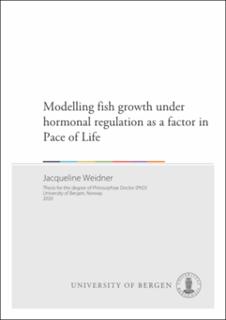| dc.description.abstract | This thesis is written with the aim to increase the holistic understanding of growth in fish. As stated by Tinbergen (1963), to fully understand a behaviour or trait one needs to understand several perspectives of it. Those perspectives cover proximate causes, as ontogeny and mechanisms, and ultimate causes, as phylogeny and function. Empirical studies often acquire new knowledge about a trait within the boundaries of one of those perspectives. Thus, they clearly belong to one distinct biological discipline. This is the case for purely physiological studies explaining how a certain trait or behaviour is realized in an organism, as for example the colouration of fins by metabolic carotenoids (Eckmann et al., 2017). Thereby they answer one of Tinbergen’s questions, in this case a mechanism. It is also the case for studies on purely evolutionary questions as for example whether fin coloration increases a male’s mating success (Kuwamura et al., 2000). Here, the ultimate causes of behaviour are explained. Even if Tinbergen’s four question have been summarized into two main topics; the proximate “how come” and the ultimate “what for”, as by Dennett (2017), there is still a gap separating the perspectives. About two decades after Tinbergen, Grafen (1984) nicknamed the dominant methodological tactic in evolutionary ecology for studying ultimate explanations “the phenotypic gambit”. Thus he criticized the then (and now) still common practise among evolutionary ecologists to overlook two of Tinbergen’s four questions, thereby assuming that ultimate mechanisms will serve the organism’s demands to reach evolutionary goals without any constraints. This assumption has been necessary for many evolutionary studies in which physiological explanations are inaccessible or would complicate the study design a lot. At the same time those studies take a greater distance from Tinbergen’s and later Dennett’s call for a holistic understanding. While the phenotypic gambit reduces the complexity of a trait’s cause to a primarily ultimate explanation, the opposite is the fact for pace-of-life syndromes (POLS). Having their origin in the r-/K-selection (Pianka, 1970), and later slow-fast continuums (Gaillard et al., 1989), POLS has been an extending concept now including both physiological, behavioural and ecological (Ricklefs and Wikelski, 2002, Martin Ii et al., 2006, Reale et al., 2010, Careau and Garland, 2012) factors. Slow-fast continuums build upon a suite of life history traits that change in a related manner. Individuals in species at the slow end have shorter lifespans and juvenile phase, lower survival but mature early and are highly fertile (Gaillard et al., 1989, Oli, 2004, Jeschke and Kokko, 2009). The further development of slow-fast continuums to POLS and inclusion of physiological traits, combines the ultimate life history of individuals with its proximate mechanisms. Studies show such POLSs occurring at inter-(Sepp et al., 2018) and intraspecific (Binder et al., 2016) levels. Here, I chose to follow Tinbergen in combining knowledge from distinct biological diciplines to get a better understanding of fish growth. Using a state-dependent optimazition model, the model structure allows for building a complex inner architecture of the model organism, including bioenergetics and endocrinal regulation. At the same time, decisions made by the model organisms are based on their life histories. This thesis focuses on the development of an optimization model for fish growth (Paper I & II). The model is meant to be a working tool, which can be tailored to different ecological and evolutionary questions, as shown for mortality in Paper III. The main emphasis of our work was to simplify the endocrinal system related to growth in the juvenile phase of fish (Paper I). By defining three hormone functions based on growth hormone, orexin and thyroid hormone, respectively, we designed the endocrinal system of the model organism. This system regulates growth, foraging activity and metabolism. A second important step was the implementation of the fish metabolism, here, in form of “by-demand bioenergetics”. This goal-driven control system supports individual growth with energy from foraging under the constant regulation of the endocrinal system. Parametrization was based on empirical studies on Atlantic cod, when available. If not, other studies close to cod were preferred. Concerning environmental influence on the organism we decided to focus on mortality. Model organisms can experience mortality from different sources, like foraging-related mortality or by gape-limited predators. Strategies emerging from the model are validated with empirical data. As the first paper (Paper I) mainly concerns internal aspects of the model organism, the second paper (Paper II) focuses on the environment. By advancing from a static food environment, as used in the first paper, to a stochastic food environment, simulations allow for individual differences. Stochasticity is based on an auto correlated process. In the third chapter of this dissertation (Paper III) I use the optimization model developed in the two previous chapters in an ecological context of different predation profiles. By defining a gradient along which total mortality remains approximately constant, I study the effect of mortality classes weighted differently against each other. The two mortality classes used are defined as strategy-independent, including gape-limited predation, and strategy-dependent, like foraging-related mortality. Faster pace-of-life syndromes are seen when the proportion of strategy-independent mortality increases. Thus, shortening the juvenile phase through higher endocrinally provoked growth rates. From model results we can suggest that differing predation pressures are able to result in intraspecific diversification. Although there is still much unknown territory between genes and behaviour, this thesis with its three papers shows that the ultimate evolutionary perspective can be used in combination with mechanistic understanding of molecular dynamics to reduce the size of the phenotypic gambit. | en_US |
| dc.relation.haspart | Paper I: Weidner, J., Jensen, C. H., Giske, J., Eliassen, S. & Jørgensen, C. 2020. Hormones as adaptive control systems in juvenile fish. Biology Open, 9, bio046144. The article is available at: <a href="http://hdl.handle.net/1956/21869" target="blank">http://hdl.handle.net/1956/21869</a> | en_US |
| dc.relation.haspart | Paper II: Jensen, C. H., Weidner, J., Giske, J., Budaev, S., Jørgensen, C. & Eliassen, S. Hormonal regulation of growth and survival in variable environments. The article is not available in BORA. | en_US |
